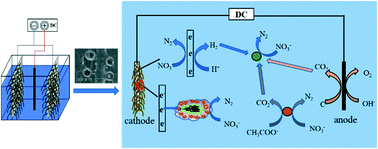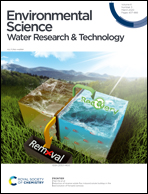Development of a novel palm fiber biofilm electrode reactor (PBER) for nitrate-contaminated wastewater treatment: performance and mechanism†
Abstract
A novel palm fiber biofilm electrode reactor (PBER) was developed, and its denitrification mechanism was analyzed by investigating its denitrification performance, extracellular polymeric substances (EPS) and microbial community. The results showed that palm fiber is a stable and efficient electrode embedding material. Almost 100% nitrate removal efficiency was achieved at 250 mA m−2 with hardly any accumulation of nitrite and ammonium. Moreover, a low energy consumption of 3.84 × 10−3 kW h g−1 NO–N was obtained. It was confirmed that nitrate could be reduced by extracellular electron transfer through fulvic acid-like and humic acid-like substances in EPS. Also, EPS promoted the biofilm stability and microbial activity at the optimal current density. Furthermore, the hydrogen autotrophic denitrifying and electroactive bacteria were significantly enriched at 250 mA m−2. Thus, this study proposes an efficient BER for nitrate-contaminated wastewater treatment and provides an approach for the evaluation of the denitrification mechanism in bioelectrochemical systems.



 Please wait while we load your content...
Please wait while we load your content...